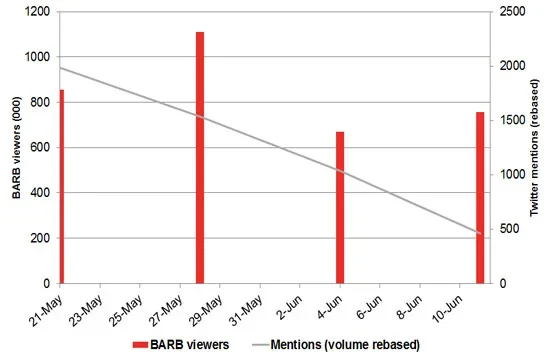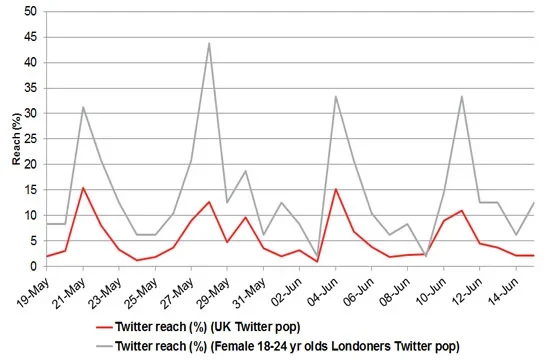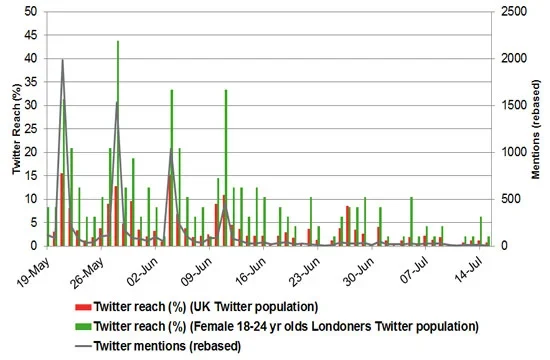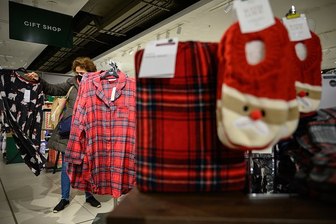'Made In Chelsea' case study shows how new tool YouGov SoMA measures social media insight
YouGov SoMA, our new social media audience measurement tool, can answer key questions for broadcasters and advertisers about their audiences and how they are reacting to content on social media platforms.
Social media is already used by TV broadcasters as a means for bartering with advertisers. A greater volume of 'mentions' equals a more engaged audience and therefore a more vocal, influential community to market to.
Here are the key insights we derived from the last 4 episodes of Channel 4’s latest Made in Chelsea series – known for its high-profile product placement throughout the programme.
1. Which episodes were successful with audiences?
Currently, the Broadcasters' Audience Research Board (BARB) provides one level of detail on the success of a show: how many people were likely to have seen it. YouGov SoMA can add further layers of detail including how they responded to that content and who made up that second 'social media audience' – readers of the TV programme or channel's Twitter and Facebook newsfeeds.
For example, the graph would imply that audiences for the last 4 episodes of the series were at their highest on May 28th. And yet, when assessing the volume of mentions of Made in Chelsea over the same period – we get succinct feedback that the show was actually less engaging than the previous episode.

2. Who were the audiences for this programme?
TV audience numbers dropped towards the end of the series, but to what extent did Made in Chelsea’s core target audience follow this trend?
YouGov SoMA clearly identifies an appetite for the show among a young female audience. This is clear by comparing the percentage of the representative Twitter population hearing about the show with the percentage of young female Twitter users hearing about it.
Over the final four weeks of the series, 40% of the UK Twitter population heard about the show on their Twitter newsfeeds at least once. 63% of female Twitter users aged 18 to 24 heard about the show over the same period. This percentage increases to 71% when looking at female 18 to 24 year olds living in London. This provides a clear measure of who exactly is the core audience for this programme.
3. How did core target audiences react to Made in Chelsea?
Given that we know that young, female, London-based audiences are fans of Made in Chelsea, we can then measure if this same audience sustained interest throughout the duration of the series.
For example, despite the Jubilee concert screening at the same time as Made in Chelsea on June 4th – 33% of 18-24 year old women in London heard about the programme on Twitter – this was a similar level to the Twitter reach achieved on May 21st and June 11th shows. This would indicate that interest was sustained among core audiences throughout the duration of the series.
One might also be intrigued by the leap in reach on the May 28th show. 'Reach' among the UK Twitter population on this date was 14%, but this goes up to 44% among female, 18-24 year old Londoners. This suggests this was clearly an episode for advertisers to make their mark on the youthful female population!

4. Who are the influencers for this programme and their advertisers?
Social media can help you identify your programme influencers and loyalists – those who continue to sustain an appetite for the show in between airing times. YouGov SoMA shows how volume of 'mentions' peaks on the nights of Made in Chelsea airs – highlighting conversations between users before, during or after the programme. It is significant however that lower mentions of Made in Chelsea between programme showings (and long after the series aired!) continue to reap large audiences – this can only be derived from influential Twitter users with large followings.

When analysing which users are achieving high reach scores, it is clear that owned handles from media publications such as Daily Mail Showbiz, Glamour and Cosmopolitan magazines, the '@E4Chelsea' account itself and the characters such as Spencer Matthews and Jamie Laing are playing a leading role – maintaining the programme’s presence in the front of the mind in their audiences.
5. Which characters should advertisers target for sponsorship and product placement?
Social media can help identify the characters that really strike a chord among audiences and have them reaching for Facebook or Twitter.

For example, Kimberley's (pictured, left) name is the most frequent character that appears on both the Facebook and Twitter newsfeeds of both men and women throughout the last four weeks of the series.
Cheska’s name was very popular for the May 21st and May 28th episodes for both men and women and yet falls off the radar completely for the final two episodes, despite appearing in the programme just as frequently.
Jamie appears more frequently on the newsfeeds of women than Spencer (pictured, right), whereas Spencer appears more frequently on the newsfeeds of men. Louise, on the other hand, doesn’t make the top ten word count of either gender’s newsfeeds for any of the episodes, with the exception of the end of season party show, where she appeared low down on the newsfeeds of women.
Overall, Kimberley and Spencer clearly achieved the highest profile (whether positively or negatively) among both men and women during the last four episodes of the series.

As our research demonstrates, TV advertisers and programmers could be looking to social media as an additional tool for identifying the audiences for their programmes and for their products, for monitoring successful programmes, content and characters during the series and as an additional source for measuring return on investment (ROI) post-finale.
For more information on YouGov SoMA and to arrange a demo – email the SoMA team at: soma@yougov.com or visit www.yougov.co.uk/soma








